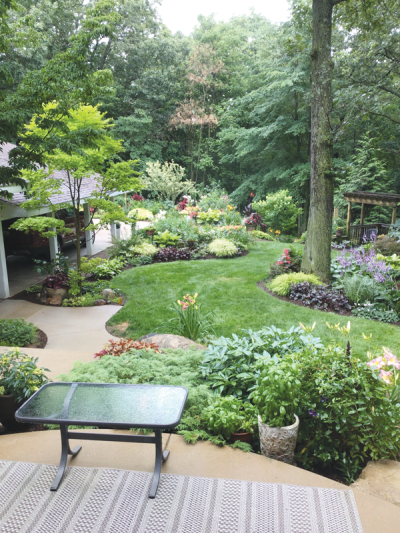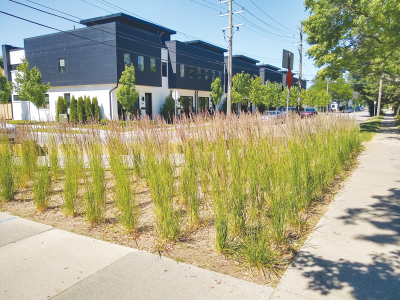
Outdoor living spaces are growing in popularity. Spending time outdoors can decrease stress and anxiety.
Photo by Rebecca Finneran
METRO DETROIT — Outside living spaces have grown in popularity over the years. As spring approaches, this is the time to start preparing lawns and gardens for “backyarding” fun.
“‘Backyarding,’ I think we came up with the term during COVID. It was the first time I heard it,” said Kris Kiser, president and CEO of the TurfMutt Foundation, which advocates for the care of outdoor spaces from yards to parks. “It’s a verb meaning to champion the outdoors and creating the spaces for your particular needs.”
According to Kiser, lawns and backyards are no longer meant just to look pretty and provide curb appeal.
“We’ve worked with Realtors who have said, ‘Young people want outdoor living spaces,’” Kiser said.
These spaces are determined with a purpose in mind and tailored to the owner’s needs and desires: a Zen space, a cooking space or outdoor fun. When planning these spaces, one must factor in kids, dogs, deer and flowering plants.
Matching the right plant to the right place is the mantra of many gardeners and growers. To find the right match, homeowners must know their climate zone, Kiser said.
“The U.S. Department of Agriculture recently updated their plant hardiness map,” said David Lowenstein, consumer horticulture supervising extension educator at the Michigan State University Macomb County Extension Office. “Now everyone is in zone 6 in the Detroit metro area.”
“What the zone information describes is the average minimum winter temperature. Zone 6A, the average temperature is minus 10 degrees Fahrenheit to minus 5 degrees Fahrenheit,” Lowenstein said. “That means the plants can survive if temperatures get to minus 10 degrees.”
Combining the right plant with the right soil can yield thriving results. Common types of soil are clay, sand and loam, according to Lowenstein.
“We do tend to have a lot of clay soil in our area,” Lowenstein said about the soil in Macomb and Oakland counties.
The soil types can vary in this area depending on how close you are to a body of water, according to Lowenstein.
“Streams have been channeled, and they’re now underground,” Lowenstein said. “Where your house is now could have once been a wetland or had a stream nearby, and that can impact the soil type.”
The right plant for the right place is as simple as a couple of clicks of the mouse, according to Kiser. Homeowners can do research on the internet into the kind of soil they have and what plants are optimal in that environment. The MSU Extension Office also has soil testers that give the nutrient composition of the soil. The testers are available in the office or online for purchase. For more information, see homesoiltest.msu.edu.
Kiser created an outdoor office during the COVID-19 pandemic and continues to enjoy it today as it draws colorful migrating birds, butterflies and a fox.
“The office has turned into a bit of an interaction with nature,” Kiser said. “It’s a disturbance I like.”
“Whatever you have, work with it.” Kiser said. That can include everything from a potted plant on a terrace to sprawling acres with plants, bushes, flowers, fruit trees and vegetables.
A beautiful outdoor garden can attract unwanted visitors. Deer love tender young plants and flowers. According to Lowenstein, it is difficult to keep the deer away completely unless there is a high fence or other barrier.
Deer typically avoid holly and ornamental grasses, according to Lowenstein. Catmint also deters deer with its fragrant scent and fuzzy leaves. Deer usually do not eat plants with hairy leaves like lamb’s ear.
Lowenstein suggests covering new plants and flowers with a cage to keep the deer away, at least until the new plants have been in the ground a month or two.
A lush green lawn can be a highlight of a beautiful outdoor space.
“Lawns look green when their fertility needs are met,” Lowenstein said. “What I mean by that is, when there is a sufficient amount of nitrogen available to them.”
Fertilizer can add nitrogen to the lawn, but err on the side of caution and do not over-fertilize, Lowenstein said. Slow-release fertilizer can be used less frequently than the fast-release variety, because slow-release continues to release nutrients.
Although metro Detroit had some unseasonably warm days in February, according to Lowenstein, the time to seed and plant will be in April.
“We could still have days that could bring us freezes, frosts or even snow,” Lowenstein said. “You don’t want to be fooled by Mother Nature and plant too early.”
Now the lawn can be mowed and any debris cleared. In a few weeks, the lawn will be ready to aerate, which involves punching holes into the ground, and to scarify, which creates grooves in the soil for grass seed to penetrate, protecting it from birds, according to Kiser. Kiser said to order plants, hardscapes and pools and arrange for labor now, because they may be more difficult to come by later in the season.
 Publication select ▼
Publication select ▼
























